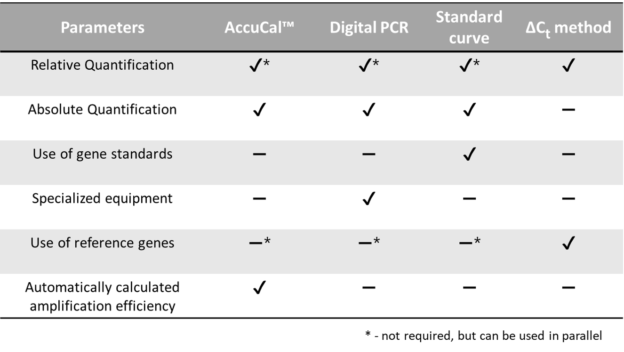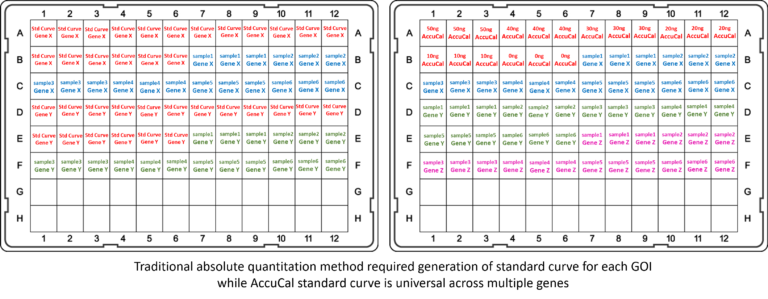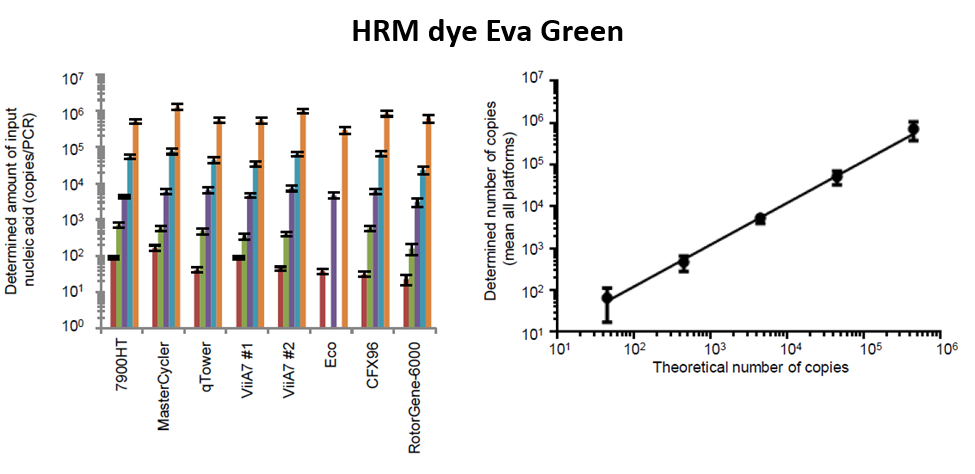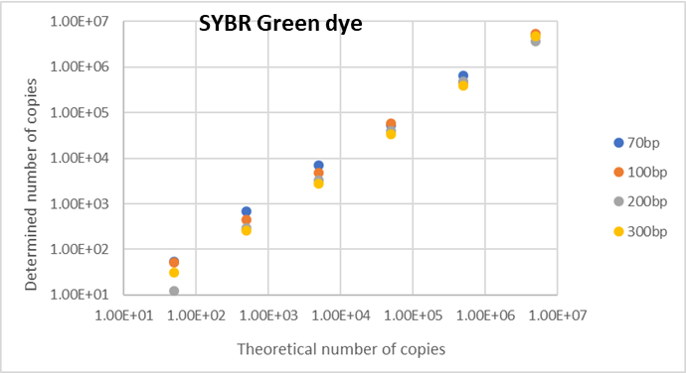
Technology
AccuCal™ / RealCount™: A new and simple method for absolute gene copy number quantification using your existing settings.
AccuCal-D™ calibrator was developed to overcome the shortcomings of using relative gene expression methods for qPCR. In contrast to relative quantification, the AccuCal-D™ method uses FL data from a qPCR run to calculate the starting copy number of a gene of interest (GOI) in a sample to give called absolute quantification.
Traditionally, to perform absolute quantification, a standard curve must be generated from known copy number inputs of serially-diluted template DNA for every GOI and reference gene. This is both time consuming and requires many additional runs prior to the experiment. Using the AccuCal-D™ calibrator standard curve method removes the requirement of traditional standard curve generation and provides absolute quantification results, i.e. number of GOI copies in your sample1. In fact, using AccuCal-D™ for absolute quantification of starting copy number eliminates the need for a reference gene altogether.
Table1 compares the requirement and capabilities of the 3 most commonly used DNA quantification methods – Digital droplet PCR, standard curve-based method and comparative Ct method with novel AccuCal™ method.

AccuCal-D™ method can be used on any instrument using master mix with HRM or SYBR® Green dyes. A universal standard curve is generated using prediluted AccuCal-D™ reagents, compared with the standard curve method, where GOI templates of known concentration have to be included in each run.
Using standard curves are a common method of determining amplification efficiency. However, the main limitation of this method is the assumption that all samples are amplified with same efficiency. Sample type and concentration, RNA isolation method and type of reverse transcriptase can inhibit the qPCR reaction. RealCount™ utilizes a method for individual amplification reaction efficiency determination from the log linear phase of the sigmoidal amplification curve. This kinetic-based approach, called “linear regression of efficiency” allows you to omit primer optimization using standard curve.
Traditional absolute quantification method is performed by constructing a standard curve for each GOI, and this is considered the gold standard for quantification in qPCR. However, each standard curve is only usable for the specific GOI, and constructing the curve is time-consuming and complex. Further, because the standards used are amplified, so too are any experimental errors. This is important as the standard curve for each GOI provides both the efficiency of the amplification primers and the amount of GOI in the unknown samples. For absolute quantification users, Accugen product reduces the number of standard curves required.

RealCount™ is a program that closely analyzes the shape of PCR amplification curve and as a result delivers absolute gene copy number in your sample at cycle zero. The software performs baseline correction, determines assay efficiency from each amplification curve using window of linearity or Rojter method2, and then using the AccuCal-D™ standard curve calculates starting concentration in copy number per sample. This method works on any qPCR instrument using your choice of HRM or SYBR® Green dye containing master mix .


Dilutions of known quantity of cDNA were amplified using HRM dyes on various qPCR platforms. The theoretical amount is plotted vs mean calculated amount, determined by RealCount software.
Theoretical number of GOI copies vs determined number of copies at cycle zero calculated by RealCount software using SYBR Green dye.
If you are not fully comfortable swapping your traditional relative quantification Ct method to the AccuCal™ absolute quantification method, you can perform your usual run, including reference genes and convert these results to absolute quantification simply by adding AccuCal™ standard curve to the same plate (12 to 18 wells). Use of reference genes or GOI standard curves, will allow you to compare between your traditional qPCR and AccuCal™ method and increase your confidence in using only one AccuCal™ standard curve in future experiments.
AccuCal-D™ does not require any special equipment, besides the reagents provided in the kit and installation of the free RealCount™ software. Reagent kits come in several sizes to suit researchers needs and enables researches to reduce number of wells used for their experiments. This combination enables researchers to achieve absolute quantification of a fraction of the price of digital PCR and/or the standard curve method.
References
- Boulter et al. (2016). A simple, accurate and universal method for quantification of PCR. BMC Biotechnology, 16(27). doi: 1186/s12896-016-0256-y.
- Ruijter et al. (2009). Amplification efficiency: linking baseline and bias in the analysis of quantitative PCR data. Nucleic Acids Res, 37(6). doi: 10.1093/nar/gkp045.
